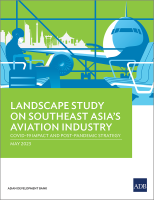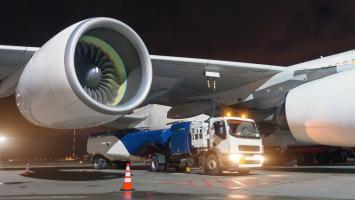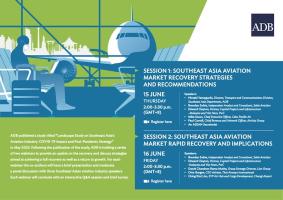The rapid expansion of the aircraft fleet in Asia and the Pacific, particularly among budget carriers, is driving the growth in demand for maintenance services. Photo credit: iStock/gorodenkoff.
Indonesia, Malaysia, and Thailand are vying to compete with Singapore, which is recognized as an international service center.
Southeast Asia is emerging as an aircraft maintenance, repair, and overhaul (MRO) hub in Asia and the Pacific. Indonesia, Malaysia, and Thailand are among the countries developing and expanding their MRO facilities and vying to compete with Singapore, which is recognized as an international service center.
Recently, Capital A and PT Garuda Indonesia announced that they are joining forces in providing maintenance services for jetliners. Capital A is the parent company of Malaysian budget carrier AirAsia.
A report from research firm Mordor Intelligence estimates the market size of the aircraft MRO in Southeast Asia at $5.34 billion in 2024 and expects it to reach $7.12 billion by 2029, growing at a 5.94% compound annual growth rate (CAGR) during the forecast period (2024–2029).
Expanding aircraft fleet
The rapid expansion of the aircraft fleet in Asia and the Pacific, particularly among budget carriers, is driving the growth in demand for maintenance services.
In Southeast Asia alone, Boeing sees fleet size to more than triple to 4,960 jets to meet the rising air travel demand over the next 20 years.
“With Southeast Asia’s economy forecast to have the second-highest growth rate among global regions, rising household incomes will bring new consumers into this aviation market, fueling growth for low-cost and leisure business models,” says David Schulte, managing director of Boeing Commercial Marketing for Northeast Asia, Southeast Asia and Oceania.
“Southeast Asia’s growing fleet—especially single-aisle airplanes—will play an important role in further connecting the region’s island geography and serving travel demand across the Asia–Pacific region,” he says, particularly routes to the People’s Republic of China as well as Northeast Asia.
In July, Philippine budget carrier Cebu Pacific signed an agreement with Airbus to purchase up to 152 single-aisle A32neo aircraft. AirAsia is also adding A32neos to its fleet, which is expected to exceed 300 aircraft within the next 5 years. Both airlines are increasing flight services, including to key destinations in the BIMP-EAGA subregion.
Southeast Asia is well-positioned to provide maintenance services to the Asia–Pacific region, which is currently the fastest-growing MRO market. Mordor Intelligence estimates the size of the Asia–Pacific market at $22.60 billion in 2024. It projects the market to grow to $30.69 billion by 2029.
“Over the last 2 decades, Southeast Asia has been making the most of its favorable geographic location by complementing it with state-of-the-art aviation infrastructure,” the research firm says. “The region's strategic position and the strong local supply chain have contributed to its position as a preferred location for many MRO companies. Maintenance constitutes a major portion of the financial business model of aircraft operators in the region.”
Key players
Top MRO operators in Southeast Asia include ST Engineering (Singapore), SIA Engineering (Singapore), Safran SA (France), GMF AeroAsia (Indonesia), Thai Maintenance (Thailand), and Sepang Aircraft Engineering (Malaysia).
Singapore is the dominant player in the region with ST Engineering considered as one of the world’s leading MRO operators. According to Mordor Intelligence, the island state has the capacity to provide complete aircraft services and serves a quarter of Asia’s MRO requirements and a tenth of global demand.
Even before the pandemic, MRO operators in Indonesia, Malaysia, and Thailand were already challenging Singapore’s position in the market by offering low-cost services. These include the maintenance units of national carriers Garuda Indonesia, Thai Airways International, and Malaysia Airlines.
Last year, Capital A’s aircraft maintenance provider Asia Digital Engineering (ADE) and Garuda Indonesia’s GMF AeroAsia started discussing a strategic partnership that will deliver value-driven, low-cost MRO services to other airlines. The plan is part of a larger deal between Capital A and PT Garuda Indonesia to expand their network across various business lines, including commercial airline services and logistics services.
In September this year, ADE and GMF AeroAsia launched a $12-million joint venture to provide landing gear solutions to customers in Southeast Asia starting next year. ADE also announced the opening of a 14-line MRO hangar with advanced facilities at the KLIA Aeronautical Support Zone, including a digital product development center.
In the meantime, ST Engineering is expanding its hangar facility at Changi Airport. A new airframe maintenance facility will have green and smart technology features, such as solar panels, automated guided vehicles for transporting tools and parts, and digital tools for paperless operations.

BIMP-EAGA
The Brunei Darussalam–Indonesia–Malaysia–Philippines East ASEAN Growth Area, or BIMP-EAGA, is a cooperation initiative established in 1994 to spur development in remote and less developed areas in the four participating Southeast Asian countries.


